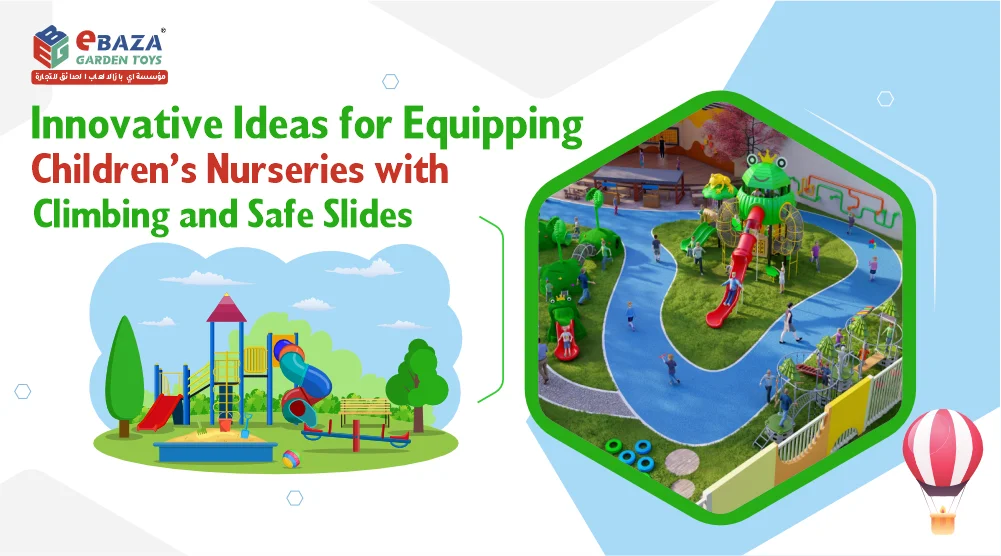Innovative Nursery Ideas with Climbing Structures and Slides
Innovative Ideas for Equipping Children’s Nurseries with Climbing and Safe Slides
Introduction: The Importance of Climbing and Slides in Children’s Nurseries
Children’s physical and cognitive development is significantly enhanced by active play. By equipping nurseries with climbing structures, high-quality plastic slides, and foam playsets, we can provide an environment where children can learn, grow, and interact safely. In addition to outdoor playgrounds, indoor foam mats and plastic play equipment add versatility and safety to play areas.
In this blog, we explore innovative ideas for designing safe, engaging, and developmental play environments with both indoor and outdoor play equipment.
Types of Play Equipment for Nurseries
Outdoor Climbing Structures
- Monkey bars and climbing walls are excellent for improving children’s physical strength and balance.
- Integrated climbing towers with tunnels and slides offer diverse activities that keep children engaged.
- Ropes and obstacle courses promote teamwork and adventurous play, enhancing both physical and social skills.
Plastic Slides for Outdoor Areas
- High-quality plastic slides are durable and ideal for nursery playgrounds. They are designed to withstand varying weather conditions, such as heat and rain, making them perfect for outdoor use.
Indoor Play Equipment
- Foam playground toys offer a soft and safe play environment for younger children. They reduce the risk of injury and provide opportunities for creative, unstructured play.
- Foam mats are essential for protecting children during active indoor play sessions.
- Plastic playhouses and indoor climbing frames allow for imaginative and role-based play, helping children develop creativity and problem-solving skills.
Benefits of Combining Indoor and Outdoor Play Areas
Physical Development
- Climbing equipment and slides help improve muscle strength, hand-eye coordination, and motor skills.
- Foam play areas provide a safer alternative for toddlers who are still developing their balance.
Cognitive and Social Development
- Interactive play equipment, such as balance games and group activities, encourages cooperation, communication, and teamwork.
- Imaginative play with plastic houses and obstacle courses fosters creativity and cognitive flexibility.
Enhanced Safety Features
- Indoor foam mats and rubber flooring in outdoor areas create a safer play environment by cushioning falls and reducing injury risks.
Ideas for Designing a Balanced Play Area
Efficient Use of Space
- Organize the play area to include both structured play (e.g., slides and swings) and free play zones (e.g., foam play structures).
- Designate specific zones for different types of activities, such as climbing, sliding, and group games.
Themed Play Structures
- Themed designs, such as castle towers or animal-shaped slides, make the play area more exciting and visually appealing for children.
- Adding tunnels and hidden pathways enhances exploration and adventure within the play space.
Safety Considerations for Nursery Play Areas
Securing Equipment Properly
- Ensure that outdoor play equipment like swings and climbing frames are anchored firmly to prevent movement or tipping.
Selecting Non-Toxic Materials
- Use equipment made from safe, non-toxic materials, such as BPA-free plastic and eco-friendly coatings.
Regular Safety Checks
- Perform regular inspections of moving parts, such as hinges and chains, to ensure they are functioning properly and free of damage.
Choosing the Right Equipment for Different Age Groups
- Toddlers (Ages 1-3)
- Foam play structures, low slides, and soft mats are ideal for this age group to ensure safety during play.
- Preschoolers (Ages 3-5)
- More challenging activities, such as climbing walls and monkey bars, can help develop physical confidence and coordination.
- Older Children (Ages 5-7)
- Interactive games, obstacle courses, and advanced climbing structures promote skill development and team interaction.
Indoor Play Equipment for Active Learning
Foam Play Sets for Safety
- Foam play equipment is designed to absorb impact and provide safe exploration zones, especially for younger children still learning to balance.
Plastic Playhouses for Imaginative Play
- Indoor playhouses offer endless opportunities for role-playing, which helps in social development and creativity.
Sensory and Balance Equipment
- Sensory play stations stimulate children’s senses and help improve focus and attention span.
- Balance-based activities like stepping stones or balance boards encourage physical control and coordination.
Maintenance Tips for Play Equipment
Regular Cleaning
- Indoor equipment like foam mats and plastic playhouses should be cleaned regularly to prevent dust and bacteria buildup.
Preventive Maintenance
- Check for signs of wear on rubber flooring, foam toys, and outdoor climbing frames to ensure long-term safety.
Customizing Play Areas for Nurseries
Multi-functional Play Structures
- Opt for equipment that combines multiple activities, such as a play tower with integrated slides, climbing walls, and interactive games.
Seasonal Adjustments
- Add shade structures or canopies over outdoor equipment to protect children from direct sunlight, especially in hot climates.
Enhanced Accessibility
- Include ramps and accessible play equipment to ensure that all children, including those with special needs, can participate fully in play activities.
Adapting Play Equipment to Different Environments
Hot Climates
- In areas with high temperatures, such as Riyadh or Jeddah, use heat-resistant materials for outdoor equipment and install shaded play zones.
Compact Spaces
- For nurseries with limited indoor space, modular play structures and portable foam toys can maximize available room without compromising activity options.
Encouraging Safe and Active Play
Organizing Play Activities
- Design daily play sessions that combine both structured activities (like obstacle races) and free play to maintain children’s interest.
Supervising Play Areas:
- Always ensure that play areas are supervised by trained staff who can monitor safety and promote positive interactions among children.
Conclusion: Creating a Fun and Safe Learning Environment
Equipping nurseries with climbing structures, plastic slides, foam playground toys, and interactive play equipment helps create a well-rounded environment for children. By prioritizing safety, creativity, and physical development, nurseries can provide memorable experiences that foster growth and learning.

